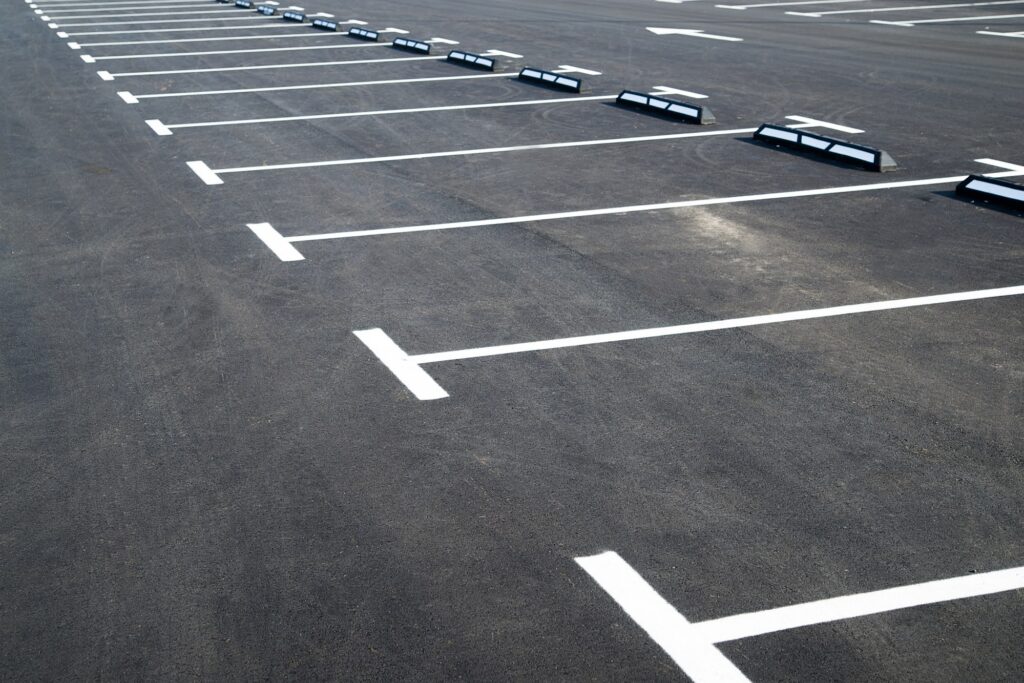

Parking lot markings play a critical role in organization, safety, and compliance, providing clear guidance for vehicles and pedestrians. Yet, choosing the right material for these markings can be a challenge, especially when durability is a primary concern. Two of the most common options are thermoplastic and paint, each offering unique benefits and drawbacks. To simplify the decision-making process, this article will compare the two materials based on durability, cost, maintenance, and application.
Durability
When it comes to longevity, thermoplastic typically outperforms paint. Thermoplastic is applied as a heated material that bonds to the pavement, creating a hard and durable surface. It can withstand heavy traffic, extreme weather, and general wear and tear for several years without significant fading or deterioration. This makes it ideal for high-traffic areas or locations with harsh environmental conditions.
Paint, while effective in the short term, is more prone to fading and chipping over time. Traditional traffic paints like water-based acrylic or solvent-based formulations provide an economical solution for low-traffic areas, but they require more frequent reapplication. Paint marking longevity often depends on factors such as climate, traffic levels, and the quality of the paint used.
Cost
Cost is a key consideration in choosing parking lot marking materials. Initially, paint is the more affordable option. It requires less specialized equipment and has a lower upfront cost for materials and labor. This makes it a popular choice for smaller projects or facilities with tight budgets.
Thermoplastic, on the other hand, entails a higher initial investment. The equipment and expertise required to apply it add to the costs, as do the material prices. However, its extended lifespan often results in lower long-term costs. Because thermoplastic markings need less frequent maintenance or replacement, they can provide better value for large-scale or heavily trafficked projects.
Maintenance
Maintenance requirements differ significantly between the two materials. Thermoplastic is known for its durability, meaning fewer touch-ups and repairs over time. Its resistance to fading and cracking reduces the need for frequent maintenance, making it a more reliable option for long-term performance.
Paint, however, requires more ongoing care. Exposure to UV rays, road salt, rain, and heavy traffic causes paint markings to degrade faster, necessitating regular repainting to maintain their visibility and effectiveness. For facilities needing to minimize downtime and avoid frequent disruptions, this added maintenance may be a drawback.
Application Process
The method of applying these materials also plays a role in decision-making. Thermoplastic requires a more advanced application process that involves heating the material to high temperatures. It must be applied using specialized equipment, which ensures a strong bond to the pavement surface. However, this method necessitates skilled operators and proper preparation of the work area, typically leading to a longer installation process.
Paint, in contrast, is simpler and faster to apply. It can be sprayed or rolled onto the pavement with minimal equipment and preparation. This ease of application makes it suitable for projects requiring quick turnaround times. Paint’s shorter drying time also allows parking lots to reopen sooner after marking, which is beneficial for minimizing disruption to operations.
Key Considerations When Choosing
Deciding between thermoplastic and paint ultimately depends on the specific needs of the project. For high-traffic areas, thermoplastic’s resilience and reduced maintenance can outweigh its higher upfront costs. However, for low-traffic zones or temporary markings, the cost-effectiveness and simplicity of paint may be more appealing.
Environmental factors also come into play. Extreme heat, cold, or moisture can degrade certain materials faster than others, influencing their lifespan. Additionally, some paints boast eco-friendly formulations, which may be a key consideration for sustainability-conscious businesses.
Choosing between thermoplastic and paint for parking lot markings involves balancing durability, cost, and maintenance needs. While thermoplastic offers exceptional longevity and value for high-traffic areas, paint provides an affordable and flexible option for smaller or temporary projects. Evaluating the unique demands of each site ensures the most practical and cost-efficient choice.
For expert advice on selecting the right material for your parking lot markings, contact us today.
